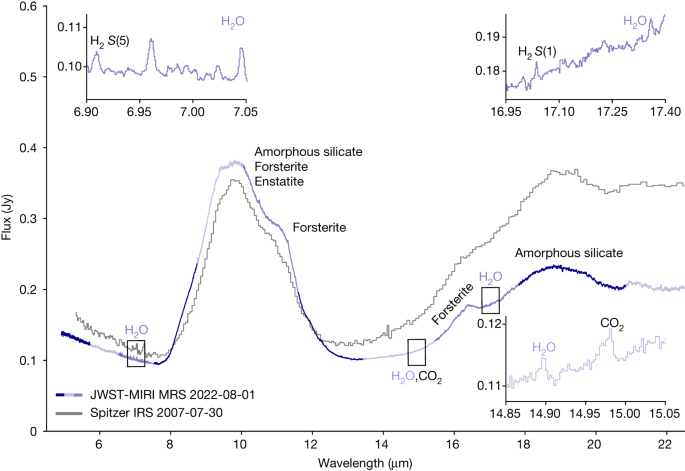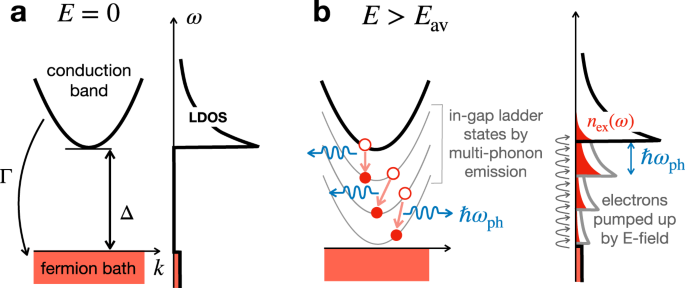ジェイムズ・ウェッブ宇宙望遠鏡の観測により、巨大惑星を持つ若い星の周りの円盤の内側に水があることが初めて発見された。 James Webb Space Telescope observations find water for the first time in the inner disk around a young star with giant planets. James Webb Space Telescope observations find water for the first time in the inner disk around a young star with giant planets.
2023-07-24 マックス・プランク研究所
◆ドイツのマックス・プランク天文学研究所の天文学者らは、約370光年離れた若い星PDS 70の惑星形成ディスクで水の検出に成功。これは岩石惑星が形成される領域として興味深い。観測は欧州の研究機関によるJWSTのMIRIを用いて行われ、水蒸気の形態で存在していることが分かった。これにより、惑星が生まれたときに水が利用可能である可能性が示唆され、岩石惑星が生命を持続させる重要な要素を持って生まれる可能性があるとされている。
◆今後の研究により、恒星周りの進化した星周円盤における水の共通性や、地球に似た岩石惑星の居住可能性についての理解が進む見込み。
<関連情報>
- https://www.mpg.de/20541783/water-rocky-planets?c=2249
- https://www.nature.com/articles/s41586-023-06317-9
PDS70星周円盤の地球型惑星形成帯に存在する水 Water in the terrestrial planet-forming zone of the PDS 70 disk
G. Perotti,V. Christiaens,Th. Henning,B. Tabone,L. B. F. M. Waters,I. Kamp,G. Olofsson,S. L. Grant,D. Gasman,J. Bouwman,M. Samland,R. Franceschi,E. F. van Dishoeck,K. Schwarz,M. Güdel,P.-O. Lagage,T. P. Ray,B. Vandenbussche,A. Abergel,O. Absil,A. M. Arabhavi,I. Argyriou,D. Barrado,A. Boccaletti,A. Caratti o Garatti,V. Geers,A. M. Glauser,K. Justannont,F. Lahuis,M. Mueller,C. Nehmé,E. Pantin,S. Scheithauer,C. Waelkens,R. Guadarrama,H. Jang,J. Kanwar,M. Morales-Calderón,N. Pawellek,D. Rodgers-Lee,J. Schreiber,L. Colina,T. R. Greve,G. Östlin & G. Wright
Nature Published:24 July 2023
DOI:https://doi.org/10.1038/s41586-023-06317-9

Abstract
Terrestrial and sub-Neptune planets are expected to form in the inner (less than 10 AU) regions of protoplanetary disks1. Water plays a key role in their formation2,3,4, although it is yet unclear whether water molecules are formed in situ or transported from the outer disk5,6. So far Spitzer Space Telescope observations have only provided water luminosity upper limits for dust-depleted inner disks7, similar to PDS 70, the first system with direct confirmation of protoplanet presence8,9. Here we report JWST observations of PDS 70, a benchmark target to search for water in a disk hosting a large (approximately 54 AU) planet-carved gap separating an inner and outer disk10,11. Our findings show water in the inner disk of PDS 70. This implies that potential terrestrial planets forming therein have access to a water reservoir. The column densities of water vapour suggest in-situ formation via a reaction sequence involving O, H2 and/or OH, and survival through water self-shielding5. This is also supported by the presence of CO2 emission, another molecule sensitive to ultraviolet photodissociation. Dust shielding, and replenishment of both gas and small dust from the outer disk, may also play a role in sustaining the water reservoir12. Our observations also reveal a strong variability of the mid-infrared spectral energy distribution, pointing to a change of inner disk geometry.



